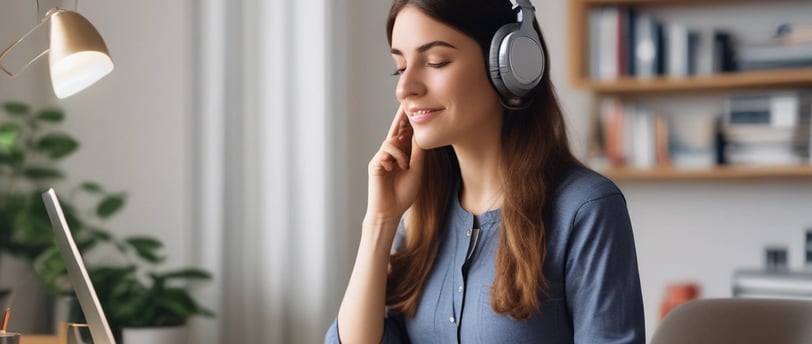Binaural Beats: A Gentle Way to Support Focus and Rest for Those Working from Home
Working from home? Discover how binaural beats can gently enhance focus and promote restful sleep. Learn how these subtle sound patterns, using specific frequencies (delta, theta, alpha, beta waves), can calm your nervous system, sharpen concentration, and ease you into restorative sleep. Explore practical tips for integrating binaural beats into your work-from-home routine, creating natural boundaries between work and rest. Support your wellbeing without complicated gadgets. Perfect for those seeking calm amidst chaos and a deeper connection to their natural rhythms.
Anna AI
5/30/20253 min read


If you’ve read our recent post on how ambient soundscapes can rescue your sleep as someone working from home, you’ll know how powerful sound can be in shaping your day and night rhythms. Binaural beats are another fascinating sound tool that can quietly support your wellbeing, especially when your home doubles as your office and sanctuary. Let’s explore how these subtle audio patterns can help you find calm, improve concentration, and ease into restful sleep—without the need for complicated gadgets or lifestyle overhauls.
What Are Binaural Beats and Why Do They Matter?
Imagine listening to two slightly different tones, one in each ear, through headphones. Your brain naturally blends these sounds and perceives a third tone—a rhythmic pulse called a binaural beat. This pulse nudges your brainwaves to sync with its frequency, gently guiding your mental state. Different frequencies encourage different moods:
Slow delta waves (1-4 Hz) invite deep, restorative sleep.
Theta waves (4-8 Hz) ease you into relaxation and creativity.
Alpha waves (8-12 Hz) bring calm alertness, perfect for unwinding or light focus.
Beta waves (13-30 Hz) spark concentration and active thinking.
For those of us balancing work and home life in the same space, binaural beats can be a subtle cue to shift gears—whether that’s settling into a focused work session or winding down after a busy day.
How Binaural Beats Can Fit into Your Work-From-Home Life
Finding Calm Amidst the Chaos
Working from home often means juggling emails, meetings, family, and household distractions all in one place. It’s easy for stress to build up when there’s no clear boundary between work and rest. Listening to binaural beats in the alpha or theta range can help soothe your nervous system, much like a mini meditation, creating a calm mental space even if your environment is busy.
Sharpening Focus When You Need It Most
Sometimes, staying on task feels like a battle. Binaural beats tuned to beta frequencies can gently boost your alertness, helping you cut through distractions and maintain steady concentration. Wearing headphones while you work can also signal to your brain that it’s time to focus, creating a psychological boundary even if your workspace is part of your living room or bedroom.
Preparing for Restful Sleep
If you’ve ever found yourself lying awake after a long day of working at your kitchen table or bedroom desk, binaural beats might offer relief. Listening to delta-frequency beats before bed encourages the brain to enter deep sleep stages, essential for physical and mental recovery. This natural aid can be especially helpful when the lines between work and rest blur, making it tricky to “switch off.”
Practical Tips for Using Binaural Beats at Home
Always use headphones. The effect depends on each ear hearing a different tone.
Choose your frequency based on your goal: beta for work focus, alpha or theta for relaxation, delta for sleep.
Pair binaural beats with a calming environment: dim lights for relaxation, a tidy workspace for focus.
Make it part of your routine: even 10-20 minutes daily can make a difference.
Combine with other habits: deep breathing, gentle stretches, or a warm drink can enhance the effect.
Creating Natural Boundaries with Sound
Just like we discussed in our ambient soundscapes post, sound can be a powerful tool to mark transitions in your day. Using binaural beats as an auditory cue can help your brain recognise when it’s time to work and when it’s time to rest. This is especially valuable when your workspace and relaxation space overlap, helping you create mental “on” and “off” switches without moving furniture or changing rooms.
What Does Science Say?
Research into binaural beats is ongoing, but current studies show promising effects. Listening to delta-frequency binaural beats has been linked with increased deep sleep duration and improved sleep quality. Other studies highlight reductions in anxiety and improvements in focus when listening to appropriate frequencies. While not a magic bullet, binaural beats are a low-risk, accessible way to support your natural rhythms and mental wellbeing.
Bringing It All Together
Working from home can be a blessing and a challenge, especially when your personal and professional worlds share the same space. Binaural beats offer a gentle, natural way to help your brain shift between focus and rest, supporting better sleep and clearer thinking. By weaving these sounds into your daily routine, you can create a sense of calm and structure that’s often missing when your home is your office.
If you’ve already tried ambient soundscapes to improve your sleep, binaural beats might be the next step to deepen your relaxation and sharpen your focus. Give them a try with an open mind and see how sound can quietly transform your day and night.
References
Huang, T. L., & Charyton, C. (2008). A comprehensive review of the psychological effects of brainwave entrainment. Alternative Therapies in Health and Medicine, 14(5), 38-50.
Lane, J. D., Kasian, S. J., Owens, J. E., & Marsh, G. R. (1998). Binaural auditory beats affect vigilance performance and mood. Physiology & Behavior, 63(2), 249-252.
Wahbeh, H., Calabrese, C., & Zwickey, H. (2007). Binaural beat technology in humans: a pilot study to assess psychologic and physiologic effects. The Journal of Alternative and Complementary Medicine, 13(1), 25-32.
Reedijk, S. A., Bolders, A., & Hommel, B. (2013). The impact of binaural beats on creativity. Frontiers in Human Neuroscience, 9, 1-7.
